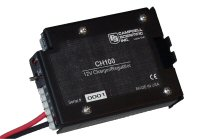This product is no longer available and has been replaced by: CH150. Some accessories, replacement parts, or services may still be available.

| Services Available |
|---|
Overview
The CH100 is a charging regulator for 12-V rechargeable batteries. This regulator provides built-in temperature compensation to optimize battery performance. It is commonly used when a rechargeable battery is required for the application and the PS150 or PS12LA power supply (7 Ahr) does not contain enough reserve amp-hours for the power supply budget.
Read More
Images

Detailed Description
The CH100 regulator connects the BP12, BP24, or other sealed rechargeable battery to an external charging source (e.g., solar panel, wall charger). The circuitry of the CH100 is similar to the PS100, but the CH100 does not include a rechargeable battery. The rechargeable battery must be capable of accepting recharge from a trickle-charge source.
The CH100 controls the current flowing to the battery and prevents the battery current from flowing to the charging source.
Compatibility
Specifications
| input Voltage (CHG Terminals) | 15 to 28 Vdc or 18 Vac RMS |
| Charging Output Voltage | Temperature-compensated float charge (for 12 Vdc battery) |
| Charging Current Limit | 1.2 A (typical) |
| Power Out (+12 Terminals) Voltage | Unregulated 12 Vdc from battery |
| Length of Red and Black Wires | ~30 cm (12 in.) |
| Dimensions | 10.2 x 7.0 x 3.9 cm (4.0 x 2.8 x 1.5 in.) |
| Weight | 158 g (5.5 oz) |
Quiescent Current |
|
| Charge Source Present | 3 to 5 mA |
| No Charge Source Present | 0 mA |
Documents
Frequently Asked Questions
Number of FAQs related to CH100: 6
Expand AllCollapse All
-
Yes, purchase pn 17200, Battery Power Cable, 7 inches. This cable includes the plug that connects to the following regulators: CH100, CH200, PS100, and PS200.
-
The CH100 Charge Controller is designed to work with maintenance-free deep-cycle lead-acid batteries. The voltage of the charger is slightly different than what is required to charge the marine-type flooded-cell battery. Therefore, Campbell Scientific recommends purchasing a deep-cycle battery, such as the BP12 or BP24, rather than a flooded-cell battery. Note that our regulated solar panels, such as the SP20R and SP10R, are intended to be used with, and connected directly to, a user-supplied flooded battery.
-
If no battery is connected, the CH100 voltage depends on the charging source. If a solar panel is connected, the voltage could vary from zero (dark sky above the solar panel) to approximately 14 V, depending on the temperature. If the CH100 is powered by an ac wall transformer and no battery is connected, the voltage would also be approximately 14 V.
Note: The battery also acts as a line filter, and Campbell Scientific does not recommend running the charger without a battery plugged in.
-
The CH100 is a float-only charger that is limited to a 20 W solar panel and a maximum load of approximately 1 A.
The more advanced (and more expensive) CH200 is a multistage controller that can charge at higher rates and use larger solar panels (90 W) while delivering a maximum of approximately 4 A to the load, depending on the temperature. The CH200 is a smart charger that incorporates MPPT technology (maximum power point tracking) and can be interrogated by the data logger to check its state, solar panel status, load currents, battery voltage, and net battery current. In this regard, the CH200 acts as a high-tech sensor, as well as a charge regulator.
The CH100 has a temperature sensor for temperature compensation. The CH200 has a similar onboard temperature sensor, but it is more efficient and does not dissipate as much heat with a similar load. The CH200 also has a feature where an independent battery temperature measurement can be sent to the charger rather than using its onboard temperature sensor.
-
A better alternative is to purchase pn 17200, Battery Power Cable, 7 inches. This cable includes the plug that connects to the following regulators: CH100, CH200, PS100, and PS200. Using one of these cables ensures that the battery voltage is correct. This is because of the voltage drop across a diode that is between the battery terminals and the 12 V load terminals.
-
The SP20 or SP20-PW solar panels can be connected in parallel (not series) to get more energy out during the day, or to extend the hours of charging (one facing east and one facing west). To accomplish this using a PS100/CH100, use the full-bridge diodes inside the PS100/CH100 as blocking diodes to prevent a shaded panel from loading down a non-shaded panel. Note that the PS100 charging current is limited to 1.2 A, thus the full benefit of both panels in full sun may not be realized.
- Connect the two separate positive outputs to the two separate charge inputs.
- Connect both return wires to the PS100/CH100 ground terminals.
The diagram below illustrates how to connect two 20 W panels:

Another method, using two blocking diodes, can be used with the PS200/CH200 charge controller:

For more information, contact an application engineer at Campbell Scientific.
Case Studies
In 2013, a sinkhole appeared next to a historic home in southern Louisiana. Over the......read more
Currently, the Andean tropical glaciers are in an accelerated process of retreat. These glaciers are......read more
Privacy Policy Update
We've updated our privacy policy. Learn More

